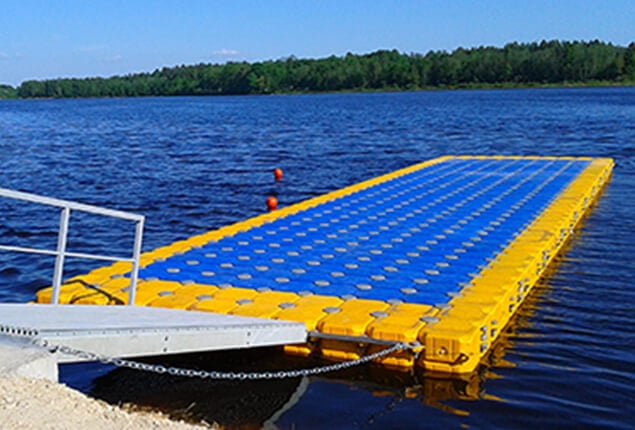Upgrade Your Beachfront With Long Lasting Floating Docks
Updating your waterside with long lasting floating docks can considerably boost both functionality and aesthetic appeals, providing a functional remedy for different water activities. With an array of products offered, including low-maintenance options and conventional timber, choosing the best dock can match your individual design and satisfy useful requirements.
Advantages of Floating Docks
Floating docks deal a wide range of benefits that boost their appeal for different maritime applications. One of the key benefits is their versatility to altering water degrees - floating docks. Unlike typical fixed docks, floating docks fluctuate with the trend, making sure regular availability for boats and boat despite ecological conditions. This feature considerably minimizes the threat of damage to vessels, as they continue to be safely tied even throughout variations in water depth.
Furthermore, floating docks are easier to mount and move, offering flexibility for short-term or seasonal use. Their modular layout permits for modification to fit details requirements, whether for exclusive marinas, domestic beachfronts, or business applications.
Furthermore, floating docks develop marginal disruption to the aquatic atmosphere, preserving neighborhood communities and lowering the likelihood of erosion. They additionally offer improved safety and security and stability for customers, as their buoyant nature uses a more forgiving surface area than inflexible structures.
In addition, floating docks can assist in a diverse variety of tasks, such as angling, swimming, and recreational boating, making them an important possession for waterfront growth. Their versatility and functionality make floating docks a preferred option for a range of maritime projects.
Selecting the Right Products
Picking suitable materials for floating docks is important to their long life, performance, and general performance. When choosing products, consider factors such as ecological direct exposure, upkeep requirements, and architectural honesty. Usual products include timber, plastic, light weight aluminum, and composite options, each offering distinct advantages and disadvantages.
Timber, while visually pleasing, needs routine upkeep to stop rot and decay. Pressure-treated wood can enhance sturdiness, but it may still give in to water damage gradually. Plastic drifts, often made from high-density polyethylene, are immune to rust and call for very little upkeep, making them an attractive option for low-maintenance applications.
Aluminum is one more practical alternative, recognized for its stamina and light-weight homes. It is immune to rust and can endure extreme weather problems, although it might be more expensive than other products. Compound materials incorporate the most effective qualities of timber and plastic, offering a durable and low-maintenance choice that resembles the look of wood without the connected disadvantages.
Ultimately, the choice of product should align with the planned usage, ecological considerations, and budget constraints, making certain a long lasting and useful floating dock that meets your details requirements.
Setup Process Summary
The effective installation of a floating dock counts on careful preparation and execution, making sure that it operates properly in its desired setting. The primary step includes assessing site conditions, including water deepness, coastline functions, and dominating weather condition patterns, which will certainly notify the dock design and anchoring system.
Following the website analysis, the following phase is to prepare the floating dock parts. This consists of constructing the frame, protecting drifts, and attaching any required hardware. It is critical to ensure that all connections are durable and water-resistant to endure aquatic conditions.
Once the dock is set pop over to this site up, the installment process starts with positioning the dock in the water. This can entail a crane or other training equipment, specifically for larger structures. Correct positioning is essential for capability and safety.

Maintenance Tips for Durability
Normal maintenance is crucial for making sure the long life and optimal performance of a drifting dock. To accomplish this, begin with routine inspections at the very least two times a year, concentrating on the integrity of the dock's framework, including the flotation tools and attaching hardware. Look for signs of rust, wear, or click reference damage, and attend to any problems promptly to avoid additional deterioration.
Cleaning up is an additional important aspect of upkeep. Remove particles, algae, and barnacles from the dock's surface area to stop slippery conditions and maintain aesthetic allure. Make use of a light detergent and a soft brush to prevent harming the dock's products.
In addition, make sure that the dock is properly secured and safeguarded to hold up against seasonal modifications in water levels and weather. Check the anchoring system for click resources security and make modifications as needed.
Enhancing Your Outside Visual
To create a visually attractive exterior room, incorporating a floating dock can significantly enhance the general visual of your beachfront property. Floating docks are not just useful but can likewise work as a striking centerpiece that matches the natural environments - floating dock company. Offered in numerous materials and styles, these docks can be tailored to match your property's architectural style and landscape
The addition of attractive aspects, such as integrated lights or elegant railings, further elevates the dock's aesthetic appeal. Take into consideration utilizing all-natural timber surfaces, which mix flawlessly with the atmosphere, or choosing contemporary materials like aluminum or composite decking that offer a streamlined, modern look.
Purposefully positioning planters or seating areas on or around the dock can produce inviting spaces that encourage leisure and pleasure of waterside sights. In addition, including shades and textures that integrate with your landscape will create a cohesive aesthetic throughout your outside location.

Conclusion

Updating your waterside with resilient floating docks can substantially enhance both functionality and visual appeals, giving a versatile solution for numerous water tasks. Unlike standard set docks, floating docks increase and autumn with the trend, guaranteeing constant accessibility for watercrafts and boat no matter of ecological problems.Selecting appropriate products for floating docks is essential to their longevity, performance, and total efficiency.When the dock is put together, the setup procedure starts with placing the dock in the water.In summary, floating docks offer countless benefits, consisting of versatility to water level adjustments and a selection of material alternatives.